Exploring Greenstones Jewelry: A Comprehensive Guide
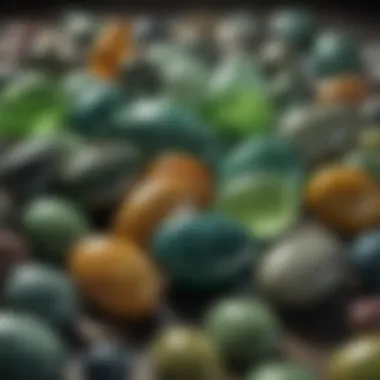
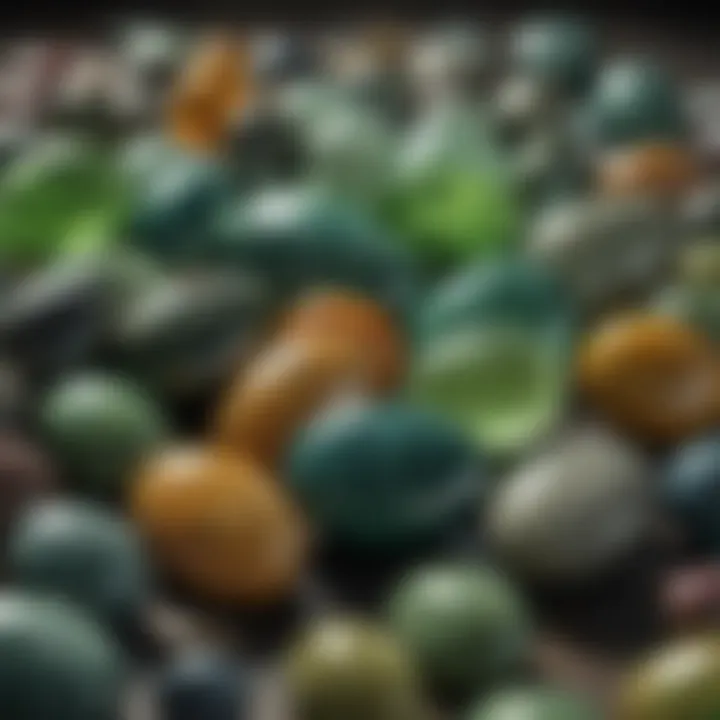
Intro
Greenstones jewelry serves as a portal into a world rich with culture, tradition, and artistry. These gems, cherished for their striking hues and unique characteristics, have captivated enthusiasts and collectors alike. This guide aims to equip you with the knowledge needed to explore the many facets of greenstones, from their historical significance to modern market trends. By delving into the stories behind these captivating stones, we hope to enhance your appreciation and understanding of their timeless beauty.
Gemstone Overview
Definition of Gemstones
At their core, gemstones are minerals that exhibit beauty and value, used primarily in decorative arts and adornments. They are often cut and polished to enhance their clarity and brilliance, transforming rough stone into radiant jewels. However, not all minerals qualify as gemstones. A gemstone must exhibit distinct characteristics like color, transparency, durability, and rarity.
Classification of Gemstones
Gemstones can broadly be categorized into two main types: precious and semi-precious. Precious gemstones include diamonds, rubies, sapphires, and emeralds. On the other hand, semi-precious stones, which encompass greenstones, include a plethora of other striking minerals. When it comes to greenstones specifically, varieties such as jadeite, nephrite, and serpentine come to mind. Each type possesses its own allure, characteristics, and historical significance, contributing to its appeal as a jewelry material.
Historical Significance
Origins of Gemstone Use
The journey of gemstones, particularly greenstones, dates back thousands of years. Archaeological evidence suggests that these stones have been valued since ancient civilizations. In regions like Māori culture in New Zealand, greenstone, or pounamu, is not merely a material, but a symbol of status and identity. Its history intertwines deeply with cultural rituals and crafting traditions.
Cultural Insights: Gemstones in Ancient Civilizations
Throughout history, different civilizations have harnessed the power of greenstones and other gemstones. The Egyptians, for instance, prized turquoise and lapis lazuli. Similarly, greenstones held great significance in many indigenous cultures worldwide, often crafted into tools, ornaments, and amulets.
"The stone that is often regarded merely as jewelry carries stories of the past, woven through history, culture, and spirituality." - Anonymous
Across various cultures, greenstone has been revered not just for its aesthetic appeal, but also for beliefs surrounding protection, healing, and prosperity.
In summary, the world of greenstones jewelry transcends mere adornment. It offers a rich tapestry of cultural narratives, historical significance, and artistry that invites every collector and enthusiast to participate in its journey.
Preface to Greenstones Jewelry
Greenstones jewelry stands as a testament to the enduring allure of natural gemstones. The appeal of these pieces transcends mere aesthetics; it hints at cultural heritage, geological marvels, and a deep-seated emotional resonance. In this article, we’re setting the stage to explore not just the visual beauty of greenstone jewelry, but also its profound significance in various societies throughout history. Understanding the topic of greenstones is crucial for both enthusiasts and collectors alike, serving as a foundation for appreciating the artistry and value behind each piece.
Defining Greenstones
Greenstones, broadly speaking, are a range of precious stones that exhibit a green hue, primarily comprised of minerals like nephrite and jadeite. They are often steeped in history, with ancient civilizations treasuring them for their beauty and metaphysical properties.
Greenstones can span a spectrum of shades, from deep forest greens to light olive tones. But it’s not just the color that captivates; it's the texture and the unique way light interacts with the stone's surface. For many, these characteristics make greenstones stand out amidst the wide array of gemstones.
While nephrite is known for its toughness and matted texture, jadeite boasts a glassy appearance and higher value in the market. Knowing the distinction between these types and their specific defining characteristics is vital for any aspirant jewelry collector. It sets the stage for what one should look for when acquiring a piece of jewelry, ensuring that a purchase is based on knowledge rather than mere visual appeal.
The Allure of Greenstones
The allure of greenstones lies not only in their captivating appearance but also in centuries of history and lore surrounding them. These stones have served numerous roles throughout cultures, often considered symbols of power, protection, and prosperity.
For instance, in Māori culture of New Zealand, greenstone or pounamu holds significant spiritual importance. It is traditionally carved into tools, weapons, and ornaments, believed to carry mana, or spiritual essence. Similarly, ancient Chinese culture revered jade, often associating it with purity and virtue.
"Greenstones are not merely ornaments; they are stories carved in stone, echoing the whispers of time and culture beneath their polished surfaces."
Moreover, the way production techniques and craftsmanship have evolved adds another layer to their charm. Each piece of jewelry embodies a human touch, blending precision with artistry. Thus, when one dons a greenstone necklace or ring, they carry a piece of history, a conversation starter, and a slice of someone’s passion for craftsmanship.
Historical Context
Understanding the historical context of greenstones jewelry is crucial for grasping its significance in both cultural and artistic realms. This rich heritage layers meaning onto each piece, transforming mere adornments into vessels of tradition and stories. The journey of greenstones through history offers insights into the societal values and practices associated with their use.


From the ancient tribes that revered these stones for their strength and beauty, to their evolution into symbols of status and wealth, the past of greenstones is as multifaceted as the gemstones themselves. Recognizing these narratives not only enriches one’s appreciation for greenstones but also underscores their role in connecting humanity across ages.
Ancient Uses of Greenstones
Greenstones, especially nephrite and jadeite, have been utilized since ancient times. Cultures around the world employed these stones not solely for ornamental purposes but also for practical applications. In certain Māori traditions, greenstone, or "pounamu," was carved into tools, weapons, and ceremonial artifacts. Each piece held a piece of cultural heritage, acting as a physical manifestation of identity and status.
The classic use can be seen in stone tools crafted during the Neolithic era. Here is how different societies have historically embraced greenstones:
- Māori Culture: Besides weapons, pounamu served spiritual purposes, believing it housed mana, a life force.
- Chinese Civilization: In ancient China, jade was associated with virtues like purity and moral integrity, often carved into ornaments for the elite.
- Mesoamerican Cultures: Cultures like the Olmecs and Maya used jade in burial practices and as offerings in temples.
These ancient uses illustrate not only utility but also a deep reverence for the stone, often aligning with spiritual beliefs.
Cultural Significance in Various Societies
Beyond their physical utility, the cultural significance of greenstones varies greatly across regions and eras. The stone's intrinsic qualities—such as its durability and aesthetic appeal—have forged its central role in tradition and rituals. Across the globe, greenstones symbolize connections to nature, cultural identity, and personal protection.
- Māori Traditions: Here, pounamu represents lineage and connection to ancestors. Its gifting is a profound gesture of love and respect and often marks significant life events.
- Asian Cultures: In many Asian societies, jade pieces are commonly gifted to signify protection, love, and prosperity. The Chinese even consider jade a symbol of health, eternal life, and harmony.
- Native American Tribes: For some tribes, greenstones are used in medicine wheels and other ceremonial practices, believed to harness healing energies.
Understanding these cultural contexts provides richer layers to appreciating jewelry crafted from greenstones. It becomes apparent that each piece may embody a lifetime of stories, beliefs, and craftsmanship.
In summary, the historical aspects of greenstones jewelry reveal its evolution, significance, and the human relationships woven into its tradition. As gemstone enthusiasts delve into greenstones, recognizing these roots offers a more profound connection not just to the stones themselves, but also to the myriad of cultures that have cherished them throughout time.
Types of Greenstones
When it comes to greenstones jewelry, understanding the different types is crucial. Each kind has unique properties, cultural significance, and appeal, catering to various preferences among collectors and enthusiasts alike. From the mesmerizing shades of nephrite and jadeite to the lesser-known variants, knowing these distinctions adds depth to one’s appreciation of the craft. Moreover, the type of greenstone can influence everything from the design of a piece to its market value.
Nephrite and Jadeite
Nephrite and jadeite, the two most prominent types of greenstones, often take center stage in discussions about these captivating gems.
Nephrite is known for its toughness and versatility. Historically, it has been favored in the production of tools and ornaments by various cultures. Its color ranges from deep green to grey-green, often displaying a subtle translucency. What sets nephrite apart is its unique fibrous texture, which can be both a strength and a point of intrigue for artisans. Jewelry makers appreciate it for its ability to withstand wear and tear while maintaining its aesthetic beauty.
Jadeite, on the other hand, tends to steal the spotlight with its vibrant hues and rarity. This variety is prized for its clarity and the spectrum of colors it offers, from emerald greens to pale lavenders. Jadeite is often seen as a luxury material, fetching higher prices in the market compared to nephrite. Its formation is typically found in metamorphic rocks, making it less common than nephrite, which has a broader distribution.
Both nephrite and jadeite contribute significantly to gemstone jewelry, but their market dynamics differ based on availability, craftsmanship involved, and buyer preferences. For collectors, the choice between these two can be a matter of personal style and the story behind each piece.
Other Variants
While nephrite and jadeite dominate discussions, other greenstone variants deserve attention as well. These include serpentine, green quartz, and aventurine. Though not as commonly classified strictly as greenstone, they add diversity to the market and can often be found in various jewelry offerings.
- Serpentine: Often appreciated for its earthy, subtle tones, this variant tends to have a waxy luster. Its green hues range from pale to dark, sometimes featuring mottled patterns. Artisans often use serpentine for carving figurines or intricate details in jewelry designs.
- Green Quartz: This stone offers a refreshing brightness, typically leaning towards a lighter, more transparent appearance. It's revered in both the metaphysical realm and among jewelry lovers looking for something distinctive yet understated.
- Aventurine: Recognized for its shimmering effect, brought on by natural inclusions, aventurine is a popular choice for casual jewelry designs. Its unique sparkle can add an element of surprise to any piece, making it a sought-after option.
Gemstone Characteristics
Understanding the characteristics of greenstones is like peeling an onion — there are layers upon layers of depth to consider. These characteristics play a crucial role, not only in how the stones look but also in how they’re perceived and valued in both the jewelry market and within different cultural contexts. For gemstone enthusiasts, collectors, and jewelry designers, knowing these elements can inform decisions about purchase, care, and appreciation of these unique jewels.
Physical Properties of Greenstones
Greenstones are primarily recognized for their appealing aesthetics and durability, but there's a lot more to them than first meets the eye. Let's break it down:
- Color: The vibrant greens of nephrite and jadeite vary wildly. Some stones exhibit a rich, deep green, while others showcase lighter, almost translucent shades. It's this striking coloration that often draws people in, creating a sense of allure and connection.
- Hardness: Both nephrite and jadeite rank relatively high on the Mohs scale. Nephrite sits around 6 to 6.5, while jadeite can range up to 7. This hardness ensures that greenstones are not only beautiful but also resilient, making them suitable for daily wear in jewelry.
- Texture: The surface texture can vary; some pieces have a smooth, glossy finish, while others may present a more rough-hewn appearance. This variability often signifies the craftsmanship involved in the making process.
- Transparency: Greenstones can range from opaque to translucent. This characteristic can influence their valuation significantly, with translucent stones typically being more sought-after.
- Luster: Reflective properties impact how light interacts with the stone. The lustrous sheen of high-quality jadeite, for instance, can elevate a piece of jewelry into the realm of the extraordinary.
The physical properties not only add to the stone's beauty but also inform you about how to care for it. For instance, not all greenstones are the same when it comes to cleaning. Knowing these distinctions assists in maintaining the integrity and appearance of each piece.
Metaphysical Properties and Beliefs
When you delve into the realms of metaphysical properties and beliefs surrounding greenstones, you find a treasure trove of cultural significance and emotional connection. Many believe that these stones carry vibrational energy that can affect one's mood, mind, and even physical health. The customs and stories tied to these beliefs shape perceptions around the world. Here are some common ideas:
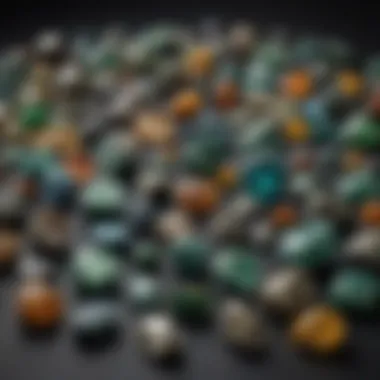

"Greenstones are often thought to act as protectors of the heart, fostering love and compassion."
- Healing Properties: Some enthusiasts claim that greenstones can help alleviate physical ailments. From traditional beliefs in various cultures to modern holistic practices, these stones are said to have soothing properties, especially in relieving stress and anxiety.
- Spiritual Guidance: Greenstones are sometimes viewed as a bridge to higher consciousness. They may encourage insights, introspection, and a deeper connection with nature. Many wear them as a talisman of peace and grounding.
- Symbol of Harmony: Beyond their healing attributes, many see greenstones as symbols of prosperity and harmony. This belief often correlates with their place in histories, such as being used in ceremonial items of ancient cultures.
- Cultural Significance: Different societies have unique interpretations. For example, Maori culture treasures greenstone (or pounamu) for its spiritual significance and craftsmanship. The stone is more than just a material; it's part of a narrative that spans generations.
By understanding both the physical and metaphysical qualities of greenstones, one gains a more profound appreciation for these gemstones. Whether worn as jewelry or collected for their unique attributes, greenstones serve as a reminder of the intricate ties between nature, culture, and the human experience.
Craftsmanship in Greenstones Jewelry
Craftsmanship plays a crucial role in the world of greenstones jewelry. It is the foundation that brings the beauty and significance of each piece to life. The immense skill and attention to detail involved in crafting these unique items cannot be overstated. Unlike mass-produced accessories, greenstones jewelry often reflects a personal touch from artisans who pour their heart and soul into creating each piece. The end result is not merely an ornament, but a story encapsulated in stone, telling tales of the earth's history and cultural heritage.
Techniques Used in Jewelry Making
Creating stunning greenstones jewelry requires a range of techniques. Here are some noteworthy methods that artisans commonly utilize:
- Stone Cutting: The first step in the creation process is cutting the raw greenstone into manageable shapes. This requires careful planning to maximize the stone's natural beauty while maintaining structural integrity.
- Polishing: Once the stones are shaped, polishing is done to achieve a smooth, gleaming surface. This involves using various grades of abrasives to enhance the color and translucence of the greenstone.
- Metal Setting: Integrating metal into greenstones jewelry adds stability and style. Techniques such as soldering and prong-setting are often employed to securely mount the stones in their designs.
- Engraving and Inlay: Some artisans might select to engrave patterns or add inlaid designs, further personalizing the pieces and allowing for artistic expression.
Ultimately, these techniques meld together the raw beauty of the greenstone with the creativity of artisans, leading to unique jewelry pieces that are both beautiful and meaningful.
The Role of Artisans
Artisans are the heartbeat of greenstones jewelry. Their expertise and passion ensure that each piece is not just a product but a treasure. Here’s why artisans are so vital:
- Cultural Preservation: Skilled artisans often embrace traditional methods handed down through generations. This ensures that ancient skills are not lost, helping preserve the cultural significance associated with greenstones.
- Customization: Artisans offer personalization that mass-production simply can't match. Their ability to craft bespoke pieces creates emotional connections between the wearer and the jewelry.
- Quality Craftsmanship: Artisans generally adhere to strict guidelines concerning quality. Their commitment to craftsmanship guarantees that each piece is one of a kind, with attention to every detail.
"The beauty of greenstones jewelry lies not only in its appearance but also in the craftsmanship that brings it to life."
In the end, the craftsmanship of greenstones jewelry encompasses a beautiful blend of technique, skill, and storytelling that captivates gemstone enthusiasts and collectors alike. Understanding the painstaking effort that artisans invest helps to deepen appreciation for these stunning works of art.
Caring for Greenstones Jewelry
Caring for greenstones jewelry is not just an afterthought; it’s an essential part of maintaining the beauty and value of these precious pieces. Proper care ensures that the jewels retain their luster and vibrancy over time. Additionally, understanding how to care for these stones can prevent damage, thus preserving their emotional and cultural significance as well.
Taking care of greenstones involves nuanced understanding of their composition and characteristics. The stones can be quite delicate, and neglecting care could result in scratches, dullness, or even irreversible damage. It’s really a straightforward picture; the better the care, the longer your jewelry lasts. For those aiming to keep their collections in tip-top shape, it pays to pay attention to both cleaning methods and storage techniques.
Cleaning and Maintenance Tips
Keeping greenstones clean goes a long way in preserving their shine. Here are some straightforward tips to consider:
- Gentle Cleaning: Use a soft, lint-free cloth to wipe away dirt and smudges. If necessary, a mild soap solution works wonders. Avoid harsh chemicals that can erode the stone's surface.
- Avoid Abrasives: Never use abrasive materials that could scratch the greenstone. Even a rough sponge can be too much.
- Rinse Thoroughly: When using soap, be sure to rinse your jewelry thoroughly with clean water. Soap residue can leave a film that dulls the stone.
- Frequency of Cleaning: Regular maintenance is key. For everyday wear, a brief cleaning once a week can keep your pieces shining.
Tip: Keep an eye on any mounting or clasps. Often, these areas collect grime and can sometimes loosen the stone itself over time.
Storing Your Greenstones Jewelry
Proper storage of greenstones jewelry is crucial to maintaining their condition. Here are some methods worth noting:
- Individual Pouches: Storing each piece separately in a soft pouch can prevent scratches. Felt or fabric pouches are recommended to avoid any friction.
- Avoiding Sunlight: Direct sunlight can fade the natural color of greenstones. A dark, dry place is ideal for storage.
- Use of Jewelry Boxes: Organize your collection in a lined jewelry box or drawer. Ensure there’s enough padding to prevent movement.
- Climate Control: Humidity can affect the integrity of the stones. Ideally, keep your jewelry in a climate-controlled environment to avoid moisture damage.
By understanding how to care for greenstones jewelry, one can ensure that these beautiful pieces retain their allure and meaning. Investing a small amount of time and effort in cleaning and storage will pay dividends down the line, making the joy of wearing them even greater.
Market Trends and Value
In the realm of jewelry, understanding the market trends and value of greenstones is crucial for both collectors and enthusiasts alike. The fascination with these stone pieces goes beyond personal aesthetics; it encapsulates an understanding of their evolving significance in a constantly changing marketplace. Insights into current market dynamics can inform purchasing decisions, investments, and the overall appreciation of this unique jewelry form.
Current Market Trends in Greenstones
The popularity of greenstones jewelry has seen a noticeable surge in the past few years. Several factors contribute to this uptick in interest.
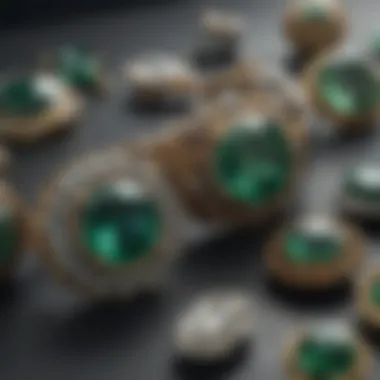
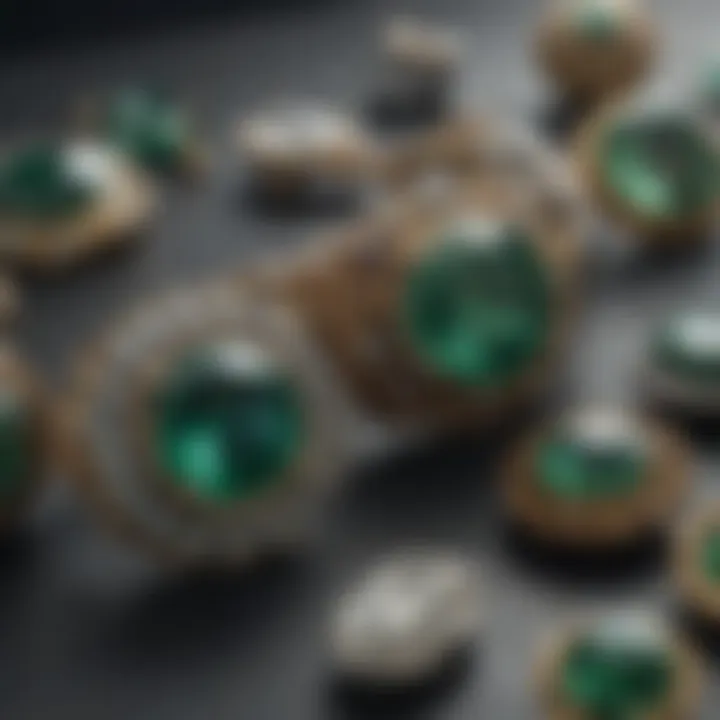
- Cultural Influence: Global movements emphasizing sustainability and ethical sourcing are driving demand for jewelry made from natural materials, including greenstones.
- Fashion Statements: Designers are increasingly incorporating greenstones in their collections, aligning them with modern aesthetic trends. The soft, earthy hues of these stones appeal to those seeking both elegance and environmental responsibility.
- Investment Awareness: The rise in awareness about investing in gemstones has made greenstones a desirable choice for those looking to diversify their portfolios.
Key trends in the market illustrate this newfound appreciation:
- Artisan Craftsmanship: There’s a growing trend toward handmade and artisan pieces, where individual stories and unique designs can elevate the perceived value of greenstones jewelry.
- Limited Editions: Collectors are particularly drawn to limited edition pieces, which often appreciate significantly over time. This scarcity factor can trigger competitive buying among enthusiasts.
- Online Marketplaces: The shift to e-commerce has broadened access, allowing buyers from all walks of life to explore diverse collections and invest in unique greenstones jewelry from the comfort of their homes.
As a whole, the market landscape is shifting, and greenstones are taking center stage. The confluence of these elements underlines the jewelry's growing significance in modern fashion and investment circles.
Investment Potential of Greenstones
Investing in greenstones jewelry can present opportunities to yield impressive returns, especially when informed by knowledge and an understanding of market demands. Here are several key points to consider regarding their investment potential:
- Intrinsic Value: The durability and unique characteristics of nephrite and jadeite signify a long-term value, as these stones possess a timeless charm.
- Market Demand: The increasing global interest in sustainable and ethically sourced jewelry suggests that greenstones will continue to gain popularity, enhancing their resale value.
- Historical Significance: Many greenstones carry cultural backstories that resonate with collectors and investors. This emotional tie can enhance value dramatically.
- Up-and-Comers: New design trends often surface that spotlight innovative uses for greenstones. Being early in identifying and purchasing these styles can lead to substantial returns down the line.
"Collecting is an art; investing requires knowledge. Master both with a committed focus on current trends, and you could find yourself on the right side of the market advantage."
Investors should approach this market with an eye for quality and a willingness to learn about the nuances of valuation. The potential for greenstones is not just in aesthetic beauty but also in their capacity to serve as a strategic investment amid changing consumer preferences.
The Future of Greenstones Jewelry
As we gaze into the horizon of greenstones jewelry, it is clear that this enchanting medium is poised for transformation and growth. The future offers a tapestry of possibilities intertwined with evolving designs, sustainability practices, and a growing consumer consciousness regarding ethical sourcing. Understanding what lies ahead can enhance both appreciation for this art form and its practical implications for craftsmanship and market dynamics.
Emerging Designs and Trends
The world of jewelry design is always in flux, and greenstones are no exception. In recent years, innovative designers have begun to experiment with non-traditional cuts and settings that reimagine how these stones are showcased. No longer are we confined to classic styles; the future whispers of asymmetrical earrings glistening with nephrite, and chunky bracelets adorned with smooth, jadeite stones.
Artisans are incorporating contrasting materials—such as metals and organic elements—to create compelling combinations that highlight the unique attributes of greenstones. For instance, pairing jadeite with recycled silver can produce a striking aesthetic while adhering to sustainable practices. Social media platforms, like Instagram and Pinterest, serve as vibrant avenues showcasing these new trends, inspiring a younger generation of consumers to embrace greenstone jewelry.
One eye-catching trend is the rise of personalized jewelry. Each piece tells a story, allowing individuals to express their identity or commemorate significant moments through custom-made designs. Whether it’s engraving a meaningful date into the setting or selecting colors that resonate on a personal level, these bespoke offerings create a deeper connection between the wearer and the jewelry.
"The beauty of greenstones jewelry lies in the infinite ways personal expression can be manifested through design."
Sustainable Practices in Greenstones Jewelry Making
In a time where sustainability is at the forefront of consumer choices, greenstone jewelry is making strides towards environmentally conscious practices. Many artisans and brands are adopting approaches that prioritize ecological integrity alongside aesthetic value. This includes sourcing stones from suppliers who adhere to strict environmental standards and promoting transparency in the supply chain.
Additionally, techniques such as recycling and repurposing materials are gaining traction. Jewelers are increasingly using reclaimed metals to minimize waste and lower the carbon footprint associated with traditional mining processes.
Furthermore, educational outreach is becoming a more significant aspect of the conversation. Workshops and online forums engage consumers with the story behind their jewelry, emphasizing responsible sourcing and craftsmanship. This connection nurtures a more profound appreciation of the stones, transforming each purchase into a meaningful decision rather than a mere transaction.
The trajectory toward sustainability invites jewelers and enthusiasts alike to join hands in fostering an industry that honors both the earth and artistry involved in creating beautiful pieces of greenstone jewelry. The future is bright, infused with hope and commitment to making conscious choices, ensuring the continued allure of these striking adornments.
In summary, the future of greenstones jewelry is not just about aesthetics; it’s also about the ethics behind them. Understanding and engaging with these emerging trends and sustainable practices will enrich our knowledge as collectors, designers, and enthusiasts.
The End
In pulling together the threads of our exploration into greenstones jewelry, it's evident that this topic bears significant weight culturally, historically, and emotionally. Greenstones, particularly nephrite and jadeite, symbolize a connection to the earth and have been cherished across various cultures for millennia. Their rich hues and unique characteristics draw both jewelry designers and collectors alike, transforming them into more than mere adornments—these pieces embody stories, heritage, and artistry.
Summarizing the Cultural and Emotional Value
The cultural significance of greenstones cannot be overstated. For many Indigenous communities, such as the Māori in New Zealand, greenstone, or pounamu, is not just a gemstone; it's a taonga, or treasure, linking them to their ancestors and the land. Wearing greenstone jewelry often goes beyond aesthetics; it reflects a person's identity and beliefs. Furthermore, the emotional value attached to these stones is profound. People carry, wear, and gift greenstones imbued with personal meanings—whether as symbols of love, remembrance, or protection. Each piece tells its own tale, heightened by the history of craftsmanship involved in its making.
Greenstone jewelry, therefore, is a vessel for emotion, communication, and connection.
Encouraging Greater Appreciation
To truly appreciate greenstones, one must delve into the rich narrative encircling them. Educational resources about these gemstones, their origins, and properties are accessible. Books, documentaries, or community discussions can shed light on the traditional techniques and modern adaptations employed by artisans in creating greenstone jewelry today.
Encouraging affinity not only elevates the craft but also bridges generational gaps in knowledge. By fostering an appreciation for the artistic effort that goes into each piece, gemstone enthusiasts can cultivate a deeper understanding of the jewelry they wear. In time, this initiative can promote sustainable practices within the industry and broaden respect for ecological responsibilities that come with gemstone mining and crafting.
"Every piece of greenstone jewelry is not merely an ornament but a continuum of stories that link past, present, and future."
By embracing this comprehensive understanding, we can uphold the legacy of greenstones, ensuring these beautiful artifacts continue to be cherished for generations to come.



